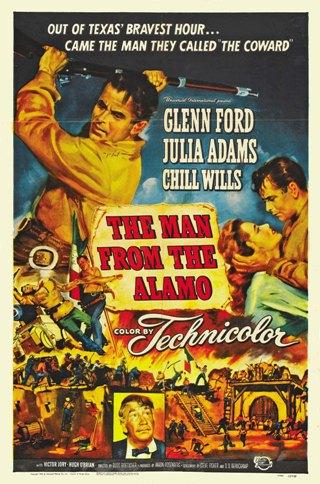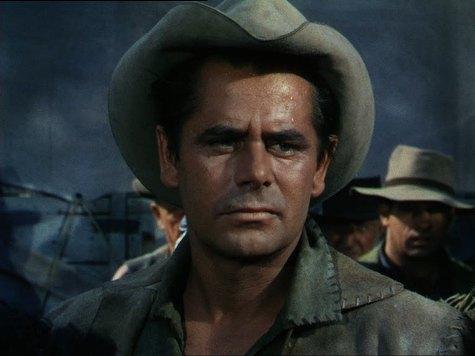
The worst that can happen to you is that somebody will say you died a hero. That man’s going to be called a coward the rest of his life.
That quote essentially sums up what The Man from the Alamo (1953) is all about – the way that courage can be misrepresented and misunderstood, how casual labeling can lead to blind, unjustified persecution. While this idea is central to the film, it’s mixed in with a standard revenge tale, and set against a backdrop of historically significant events. One could say there are the makings of an epic story here but, in the hands of Budd Boetticher, the end result is a short, tightly paced western that rarely pauses for breath and never outstays its welcome.
The opening section plunges the audience straight into the latter stages of the siege of the Alamo, with Travis’ volunteers holed up in the old adobe mission and Santa Anna’s forces massing for the final assault outside. These events have become part of American lore, and far beyond the borders of the US too if the truth be told, coming to represent grit, determination and heroic self-sacrifice. Occasions such as this have the potential to make legends of all involved, to see names honored for generations to come. However, as always, there’s a flip side to the coin. Where circumstances can see one man’s reputation soar, they can equally see that of another cast into the mud. Which brings us to John Stroud (Glenn Ford), one of the defenders of the Alamo and a man who has already proved his mettle in the heat of battle. It’s bad enough when news arrives that no relief will be forthcoming, but the situation is exacerbated for some by reports that enemy sympathizers are raiding the unprotected homesteads to the north. As a result, a handful of defenders draw lots to see who will undertake the thankless task of leaving the mission and heading off to take care of the vulnerable families. The dubious honor falls to Stroud, who accepts his fate and rides off into potential ignominy. The crucial point here is that the viewer knows that Stroud had no other choice, that he was simply dealt a lousy hand and could do nothing but play it. As it turns out, his gesture proves futile – the guerrillas have been and gone, leaving nothing in their wake but charred homes and shallow graves. Stroud is now a man bereft: his home and family are gone, and his name has become a byword for cowardice and dishonor among those not privy to all the details. All that is left is a thirst for revenge, a desire to track down and punish the renegades who have taken all he held dear. At best Stroud finds himself shunned by a contemptuous town, and at worst he risks a lynching by the more hot-headed elements. Yet, despite the threats and insults, he is committed to tracking down the real villains and, in so doing, redeeming himself in the eyes of his suspicious traveling companions while also coming to terms with his own feelings of guilt and shame.

A brief glance at the credits for The Man from the Alamo provides ample proof of its pedigree: Niven Busch and Steve Fisher feature among the writers, Russell Metty handled the photography, and Budd Boetticher occupied the director’s chair. Boetticher’s status rests mainly on the Ranown films, those pared down masterpieces with Randolph Scott. However, directors, like actors, don’t just arrive fully formed. When you come to examine almost any artist’s finest work, there’s generally a progression that can be traced leading up to that point. And so it was with Boetticher; the Ranown westerns may represent the peak of his achievements, but his earlier pictures were pointing in that direction. As I mentioned at the beginning, the ingredients were in place for a “big” movie. However, Boetticher, and the writers, trim away all the unnecessary flab to leave us with a lean piece that focuses on a driven character, an emotionally damaged outsider who measures words and actions carefully. That inner torment that Scott would so successfully portray a few years down the line isn’t quite so fully developed in The Man from the Alamo, but it’s there in embryonic form at least. I think it’s fair to say that Boetticher did his best work when he was out shooting on location. This film doesn’t have the benefit of the iconic Lone Pine locations yet the exteriors all look suitably handsome. Actually, a fair bit of the filming took place on the Universal backlot, and still looks attractive. The opening in the Alamo is extremely atmospheric, with the guttering candlelight creating a kind of grim claustrophobia, punctuated occasionally by the harsh flashes of the artillery. Generally, all of the action, and there’s no shortage of it, is well handled – the scene with the wagon train in full flight near the end is a good example of the director’s talent for exciting outdoor sequences.

Glenn Ford started his post-war career strongly with Gilda and built on it very successfully in the years that followed. By the 1950s he was getting better and better, and The Man from the Alamo was made at a time when he was approaching his peak. While there are plenty of good actors around him in this movie, a lot rests on his central performance. Ford’s experience working in film noir stands to him here as there’s more than a touch of bad luck and the cruelty of fate surrounding his character. He was always good in these kinds of roles – the outsider who’s vaguely uncomfortable with himself – and uses that ability to get properly into the character of Stroud. He could also, when he wanted, project a type of self-effacing affability and that helps draw the sympathy of the audience. If you’re going to tell a story like this – about a wronged man whose sense of personal and public honor is questioned – then it’s vital to have an everyman type like Ford whose real qualities are apparent to the viewer. Julia Adams was handed a strong role too as the woman who overcomes her initial skepticism to become Stroud’s main ally. Not only does she bring a lot of dignity to her part, but she handles the physical demands very well too. Every western needs a suitable villain and Victor Jory was an expert at playing cunning and ruthless types. Besides looking shifty and slippery, Jory had a voice that just oozed malevolence. Neville Brand was another of those perennial bad guys and is impressive in a small but memorable role. In support there are worthwhile turns from Hugh O’Brian as a priggish Texan officer who gets to eat some humble pie, and Chill Wills as the one-armed newspaperman forced to put his blustering prejudice aside.
I actually have two copies of The Man from the Alamo on DVD: the UK edition that came out first and the US release that came as part of a four movie set a few years later. Both are Universal releases, and there’s not a lot to choose between them regarding the transfer. Both are in reasonable condition with no major print damage evident, although the colors look a little muted here and there. The UK disc has a variety of language dubs and subtitles available, but the US version represents better value since three other films come with it. Certain names bring raised expectations with them, and Budd Boetticher is one of those. It would be unwise to approach The Man from the Alamo in the hope of seeing a movie of the quality of any of the Ranown pictures, but that doesn’t mean it’s an inferior movie. Frankly, it’s a good little western on its own terms, but it’s also interesting as an indication of the direction in which Boetticher was unmistakably moving at this stage in his career.
